A versatile platform for atom-light interactions
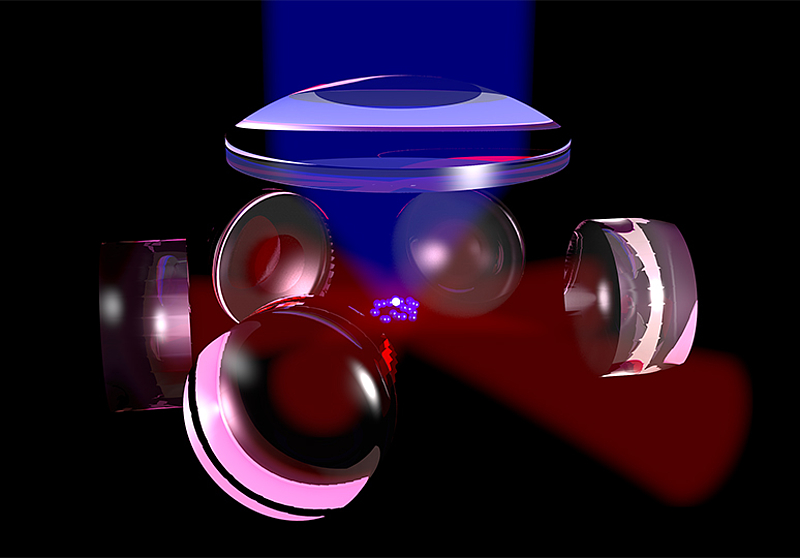 With this experiment, we explore and manipulate ultracold atoms in diverse self-generated, dynamical optical lattices provided by quantized light fields of several cavity modes. The dispersive coupling between cavity modes and quantum gases gives rise to photon-mediated interactions that can cause transitions to new quantum phases. Their static and dynamic properties can be investigated in real time in non-destructive ways by the light fields leaking from the cavities. This finite decay rate not only constitutes a powerful observable, but also alows to investigate the effect of dissipation in open systems onto quantum phases.
With this experiment, we explore and manipulate ultracold atoms in diverse self-generated, dynamical optical lattices provided by quantized light fields of several cavity modes. The dispersive coupling between cavity modes and quantum gases gives rise to photon-mediated interactions that can cause transitions to new quantum phases. Their static and dynamic properties can be investigated in real time in non-destructive ways by the light fields leaking from the cavities. This finite decay rate not only constitutes a powerful observable, but also alows to investigate the effect of dissipation in open systems onto quantum phases.
The experiment is designed in a modular way, that allows for rapid exchange of the cavity system. This enables us to explore a variety of different systems. At present, a platform with two optical high-finesse cavities that cross under an angle of 60° is loaded into the vacuum chamber.
Currently, the system is being upgraded to a Extended Fermi-Hubbard Quantum Simulation Platform (EFHQSP), where we will offer quantum simulation as a service.
Pauli crystal superradiance
10 May 2025
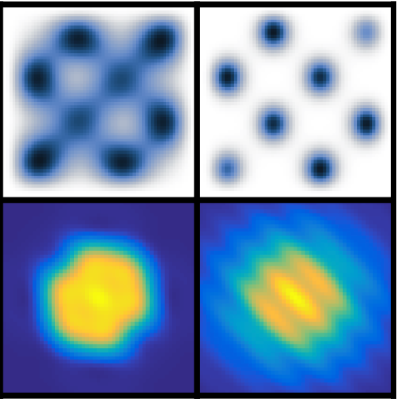 We theoretically investigate the formation of Pauli crystals — geometric structures emerging from Fermi statistics and confinement — in a cavity-fermion system. By coupling the atoms to an optical cavity, we show that degeneracies in Pauli crystals can trigger zero-threshold superradiant transitions, leading to the emergence of a true quantum crystalline state with periodic atomic density modulation. Our analytical and numerical results reveal how the interplay of quantum statistics, confinement, and light-mediated interactions enables a new route to quantum crystallization.
We theoretically investigate the formation of Pauli crystals — geometric structures emerging from Fermi statistics and confinement — in a cavity-fermion system. By coupling the atoms to an optical cavity, we show that degeneracies in Pauli crystals can trigger zero-threshold superradiant transitions, leading to the emergence of a true quantum crystalline state with periodic atomic density modulation. Our analytical and numerical results reveal how the interplay of quantum statistics, confinement, and light-mediated interactions enables a new route to quantum crystallization.
Read the preprint: arXiv:2505.02837
Synchronization of Quasi-Particle Excitations in a Quantum Gas with Cavity-Mediated Interactions
25 Apr 2025
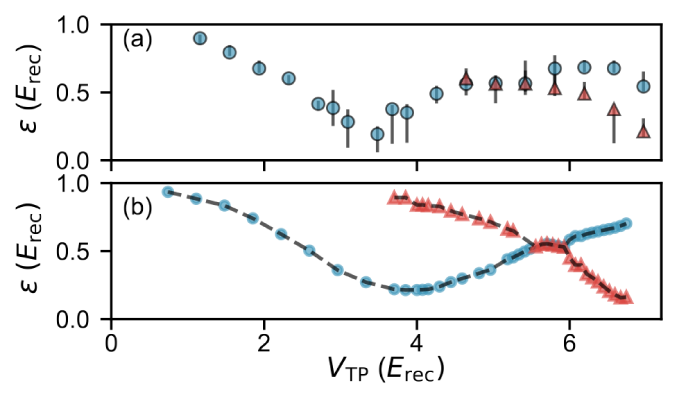 We explore synchronization in a driven-dissipative Bose-Einstein condensate coupled to an optical cavity, where dissipation induces collective behavior at the quasiparticle level. Using cavity-assisted Bragg spectroscopy, we observe the coalescence of roton-like modes at an exceptional point, signaling a precursor to a dynamical phase transition. These findings highlight how dissipation drives synchronization and collective dynamics in open quantum systems, advancing the study of non-Hermitian quantum matter.
We explore synchronization in a driven-dissipative Bose-Einstein condensate coupled to an optical cavity, where dissipation induces collective behavior at the quasiparticle level. Using cavity-assisted Bragg spectroscopy, we observe the coalescence of roton-like modes at an exceptional point, signaling a precursor to a dynamical phase transition. These findings highlight how dissipation drives synchronization and collective dynamics in open quantum systems, advancing the study of non-Hermitian quantum matter.
Read the preprint: arXiv:2504.17731
Bandstructure of a coupled BEC-cavity system: effects of dissipation and geometry
25 Apr 2025
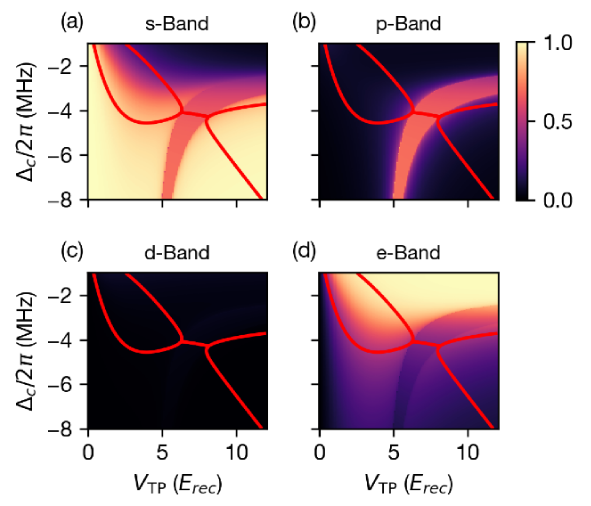 We develop a theoretical model for a transversally driven Bose-Einstein condensate in an optical cavity, focusing on how coherent and dissipative couplings influence structural phase transitions like the superradiant phase transition. Using band structure theory and a mean-field approach, we reveal non-Hermitian effects such as exceptional points and mode coalescence, while exploring the role of the pump-cavity angle.
We develop a theoretical model for a transversally driven Bose-Einstein condensate in an optical cavity, focusing on how coherent and dissipative couplings influence structural phase transitions like the superradiant phase transition. Using band structure theory and a mean-field approach, we reveal non-Hermitian effects such as exceptional points and mode coalescence, while exploring the role of the pump-cavity angle.
Read the preprint: arXiv:2504.17730
Stability and decay of subradiant patterns in a quantum gas with photon-mediated interactions
03 Aug 2024
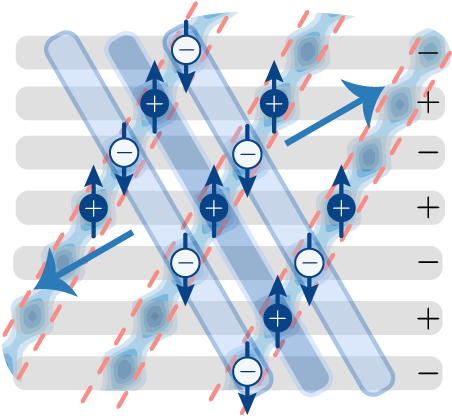 We explore subradiance—suppressed spontaneous emission—in a Bose-Einstein condensate placed at the mode crossing of two optical cavities, where metastable density structures inhibit emission into one mode. These subradiant states persist for over 100 milliseconds before an instability drives a rapid transition to a superradiant configuration. Using a quantum mean field model, we reproduce this behavior and connect it to quasi-stationary states in long-range interacting systems, highlighting the role of photon-mediated forces in quantum cooperation.
We explore subradiance—suppressed spontaneous emission—in a Bose-Einstein condensate placed at the mode crossing of two optical cavities, where metastable density structures inhibit emission into one mode. These subradiant states persist for over 100 milliseconds before an instability drives a rapid transition to a superradiant configuration. Using a quantum mean field model, we reproduce this behavior and connect it to quasi-stationary states in long-range interacting systems, highlighting the role of photon-mediated forces in quantum cooperation.
Read the preprint: arXiv:2407.09227
Laser-Painted Cavity-Mediated Interactions in a Quantum Gas
15 Jun 2024
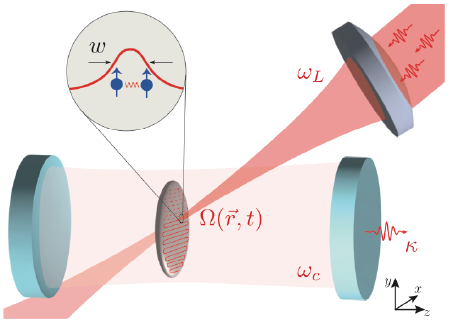 We propose a new method using a scanning laser field pumping ultracold atoms in cavities to create atom-atom interactions that can be fully tuned in range, shape, and strength. This approach makes it possible to study complex quantum behaviors that arise from long-range interactions. Our theoretical simulations show that the method works reliably and reveals rich patterns in atomic behavior, opening new paths for exploring quantum systems.
We propose a new method using a scanning laser field pumping ultracold atoms in cavities to create atom-atom interactions that can be fully tuned in range, shape, and strength. This approach makes it possible to study complex quantum behaviors that arise from long-range interactions. Our theoretical simulations show that the method works reliably and reveals rich patterns in atomic behavior, opening new paths for exploring quantum systems.
Read the paper: PRX Quantum 5, 040332
Read the preprint: arXiv:2405.07492
Self-oscillating pump in a topological dissipative atom–cavity system
21 Aug 2022
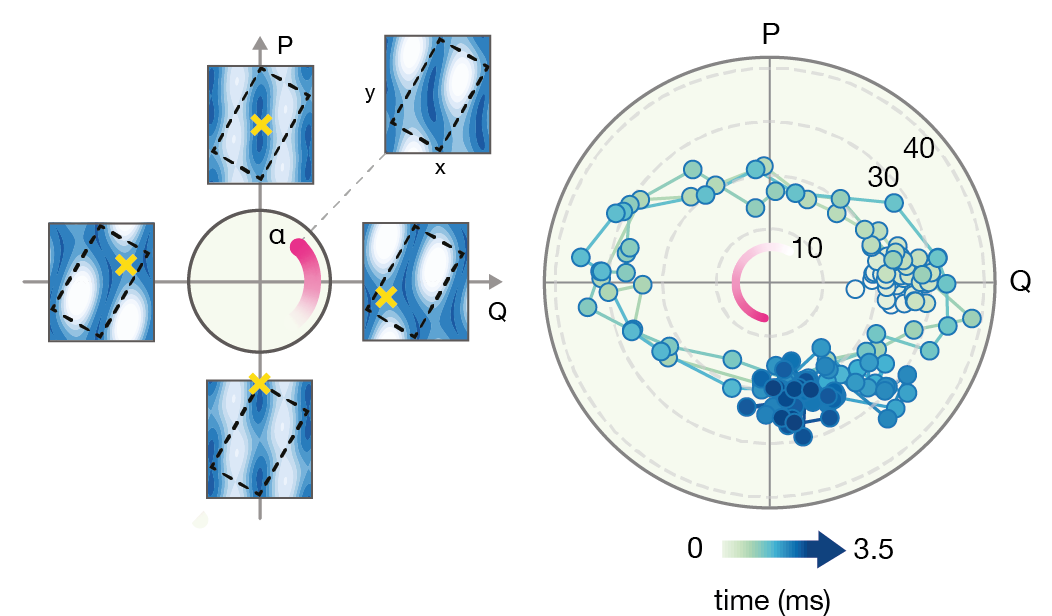 We realize a geometric pump for ultracold atoms that operates without applying any time-dependent field. Instead, cavity dissipation leads to a self-oscillation between different centro-symmetric crystal configurations. This time evolution results in a dynamical lattice potential analogous to a Rice-Mele pump. We observe the dynamics in real-time via the cavity field and as a real-space displacement of the atoms. This work combines the dynamics of topological and open systems.
We realize a geometric pump for ultracold atoms that operates without applying any time-dependent field. Instead, cavity dissipation leads to a self-oscillation between different centro-symmetric crystal configurations. This time evolution results in a dynamical lattice potential analogous to a Rice-Mele pump. We observe the dynamics in real-time via the cavity field and as a real-space displacement of the atoms. This work combines the dynamics of topological and open systems.
Read the paper: Nature 608, 494–498 (2022)
Read the preprint: arXiv:2112.11502
Read the ETH article: A quantum pump without the crank
First order phase transition between two centro-symmetric superradiant crystals
17 Apr 2020
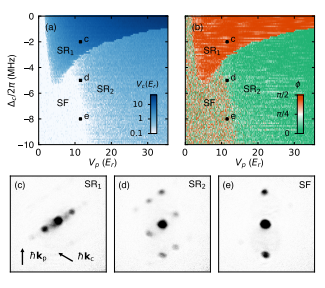 We realized a synthetic crystal with two possible spatial configurations, formed by a quantum gas self-ordering within an optical cavity.
We demonstrate how these configurations are connected by a structural phase transition.
The transition is of first order and is accompanied by transient dynamics of the order parameter which we measure in real-time, showing interesting analogy to spontaneous crystal formation and electronic dynamics in real materials.
Our work relies on a novel experimental approach based on two unbalanced coupling beams. In addition, we proved that different structures arise even from a single mode cavity, as opposed to more complicated concepts based either on multimode cavities or multiple cavities.
We realized a synthetic crystal with two possible spatial configurations, formed by a quantum gas self-ordering within an optical cavity.
We demonstrate how these configurations are connected by a structural phase transition.
The transition is of first order and is accompanied by transient dynamics of the order parameter which we measure in real-time, showing interesting analogy to spontaneous crystal formation and electronic dynamics in real materials.
Our work relies on a novel experimental approach based on two unbalanced coupling beams. In addition, we proved that different structures arise even from a single mode cavity, as opposed to more complicated concepts based either on multimode cavities or multiple cavities.
Read the paper: PRR 3, L012024 (2021)
Read the preprint: arXiv:2004.08398
P-band induced self-organization and dynamics with repulsively driven ultracoldatoms in an optical cavity
24 May 2019
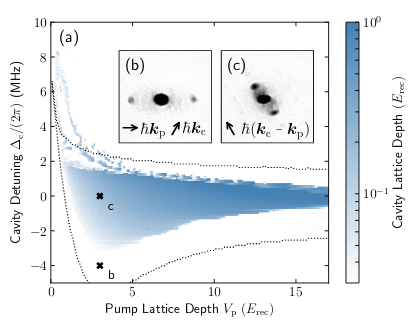 We investigate a Bose-Einstein condensate strongly coupled to an optical cavity via a repulsive optical lattice. We detect a stable self-ordered phase in this regime, and show that the atoms order through an antisymmetric coupling to the P-band of the lattice, limiting the extent of the phase and changing the geometry of the emergent density modulation. Furthermore, we find a non-equilibrium phase with repeated intense bursts of the intra-cavity photon number, indicating non-trivial driven-dissipative dynamics.
We investigate a Bose-Einstein condensate strongly coupled to an optical cavity via a repulsive optical lattice. We detect a stable self-ordered phase in this regime, and show that the atoms order through an antisymmetric coupling to the P-band of the lattice, limiting the extent of the phase and changing the geometry of the emergent density modulation. Furthermore, we find a non-equilibrium phase with repeated intense bursts of the intra-cavity photon number, indicating non-trivial driven-dissipative dynamics.
Read the paper: PRL 123, 233601 (2019)
Read the preprint: arXiv:1905.10377
Two-mode Dicke model from non-degenerate polarization modes
27 Feb 2019
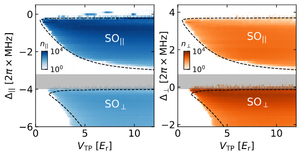 We realise a two-mode Dicke model by coupling a BEC to the two fundamental polarisation modes of a single cavity,
to which we couple via both the scalar and vectorial polarisabilities of the atoms. By independently tuning the
relative interaction strengths, we determine the effect on the self-organisation phase transition, demonstrating a
crossover from a single-mode to a two-mode Dicke model.
We realise a two-mode Dicke model by coupling a BEC to the two fundamental polarisation modes of a single cavity,
to which we couple via both the scalar and vectorial polarisabilities of the atoms. By independently tuning the
relative interaction strengths, we determine the effect on the self-organisation phase transition, demonstrating a
crossover from a single-mode to a two-mode Dicke model.
Read the paper: PRA 100, 1 (2019)
Read the preprint: arxiv:1902.09831
Coupling two order parameters in a quantum gas
17 Nov 2017
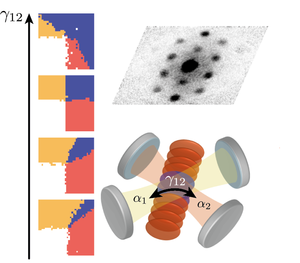 We use a quantum gas to engineer an adjustable interaction at the microscopic level between two orders, and demonstrate scenarios of competition,
coexistence and coupling between them. In the latter case, intriguingly, the presence of one order lowers the critical point of the other.
We characterize the intertwining between these orders by measuring the composite order parameter and the elementary excitations.
We explain our results with a mean-field free energy model, which is derived from a microscopic Hamiltonian.
We use a quantum gas to engineer an adjustable interaction at the microscopic level between two orders, and demonstrate scenarios of competition,
coexistence and coupling between them. In the latter case, intriguingly, the presence of one order lowers the critical point of the other.
We characterize the intertwining between these orders by measuring the composite order parameter and the elementary excitations.
We explain our results with a mean-field free energy model, which is derived from a microscopic Hamiltonian.
Read the paper on Nature materials: DOI:10.1038/s41563-018-0118-1
Read the ETH article: "Putting a quantum gas through its phases".
Read the preprint: arxiv.org/abs/1711.07988
Monitoring and manipulating Higgs and Goldstone modes
19 April 2017
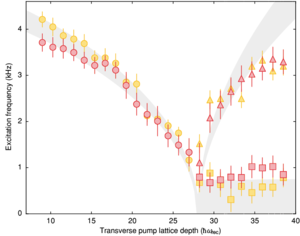 We study the Higgs and Goldstone modes in a supersolid quantum gas that is created by coupling a Bose-Einstein condensate symmetrically to two optical cavities. The cavity fields form a U(1)-symmetric
order parameter that can be modulated and monitored along both quadratures in real time. This enables us to measure the excitation energies across the superfluid-supersolid phase transition, establish
their amplitude and phase nature, as well as characterize their dynamics from an impulse response. Furthermore, we can give a tunable mass to the Goldstone mode at the crossover between continuous and
discrete symmetry by changing the coupling of the quantum gas with either cavity.
We study the Higgs and Goldstone modes in a supersolid quantum gas that is created by coupling a Bose-Einstein condensate symmetrically to two optical cavities. The cavity fields form a U(1)-symmetric
order parameter that can be modulated and monitored along both quadratures in real time. This enables us to measure the excitation energies across the superfluid-supersolid phase transition, establish
their amplitude and phase nature, as well as characterize their dynamics from an impulse response. Furthermore, we can give a tunable mass to the Goldstone mode at the crossover between continuous and
discrete symmetry by changing the coupling of the quantum gas with either cavity.
Read the paper : Science, 358, 1415-1418
Read the ETH article: "Real-time observation of collective quantum modes".
Read the preprint: arxiv.org/abs/1704.05803
Supersolid formation in a quantum gas
28 September 2016
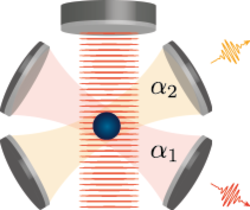 We report on the crystallization of a superfluid quantum gas to a supersolid by breaking continuous translational symmetry. The control over the coupling strength between the atomic cloud and
two optical cavities allows us to tailor the cavity-mediated interactions between the atoms in such a way, that they give rise to a structural phase transition. The continuous symmetry breaking
finds its origin at the interplay of two discrete symmetries associated with a self-organisation phase transition to each cavity. We use the light fields leaking from the cavities to monitor the
position of the crystalline structure in real time, and to directly detect the ground state degeneracy of the supersolid.
We report on the crystallization of a superfluid quantum gas to a supersolid by breaking continuous translational symmetry. The control over the coupling strength between the atomic cloud and
two optical cavities allows us to tailor the cavity-mediated interactions between the atoms in such a way, that they give rise to a structural phase transition. The continuous symmetry breaking
finds its origin at the interplay of two discrete symmetries associated with a self-organisation phase transition to each cavity. We use the light fields leaking from the cavities to monitor the
position of the crystalline structure in real time, and to directly detect the ground state degeneracy of the supersolid.
Read the paper : Nature 543, 87 (2017)
Read the ETH article : "Can a solid be superfluid ?"
Read the News & Views by K. Hazzard : Nature 543, 47 (2017)
Read the preprint : arxiv:1609.09053
Tuneable lens setup for transporting ultracold atoms
09 June 2014
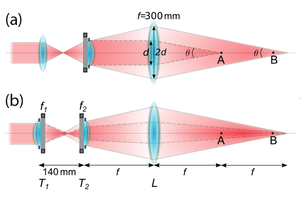 We implemeted an optical setup with focus-tuneable lenses to dynamically control the waist and focus position of a laser beam, in which we transport a trapped ultracold cloud of 87Rb over a
distance of 28 cm from our MOT chamber to the science chamber. The scheme allows us to shift the focus position at constant waist, providing uniform trapping conditions over the full transport length.
Furtheron, with the chosen configuration we can dynamically change the waist size at fixed focus position.
We implemeted an optical setup with focus-tuneable lenses to dynamically control the waist and focus position of a laser beam, in which we transport a trapped ultracold cloud of 87Rb over a
distance of 28 cm from our MOT chamber to the science chamber. The scheme allows us to shift the focus position at constant waist, providing uniform trapping conditions over the full transport length.
Furtheron, with the chosen configuration we can dynamically change the waist size at fixed focus position.
Read the paper : New J. Phys. 16 (2014) 093028
Read the preprint: arxiv:1406.2336
☞ Impact wiki
